Queen of Holland
Pronunciation:
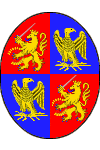
Hortense de Beauharnais, youngest of the children of Viscount Alexandre François Marie de Beauharnais, an officer in the royal army, and the Creole Marie-Josèphe-Rose de Tascher de la Pagerie, later Impress Joséphine, was born in Paris on April 10, 1783. After her parents separated in 1785, while her older brother Eugène remained in the capital with his father, Hortense accompanied their mother to Martinique in 1788. They stayed there until 1790 then returned to France.
After the Viscount's death on the scaffold in 1794, his wife was imprisoned, but was released following the fall of Robespierre, and resumed her social life, becoming the mistress of Paul Barras, the most influential man in the Directoire. In September 1795, twelve-year-old Hortense was placed in Madame Campan's boarding house at the Hôtel de Rohan in Saint-Germain-en-Laye.
On March 8, 1796, Hortense's mother married General Napoleon Bonaparte, who adopted the orphan and her brother Eugène. Hortense perfected her education at Madame Campan's, learning the fine arts (drawing and painting under the mastery of the painter Jean-Baptiste Isabey, music, dance, theater) and rubbing shoulders with her young aunts Caroline and Pauline, among other girls from Directoire and later Consulate society. She fell in love with Géraud-Christophe Duroc, aide-de-camp to the First Consul.
But on January 4, 1802, Hortense was married to Louis Bonaparte, one of the First Consul's younger brothers. The ceremony was performed by Cardinal Giovanni Battista Caprara, legate of Pope Pius VII, on rue de la Victoire. It was a political marriage (Joséphine, in particular, wished to see a second alliance seal the union of the Beauharnais and Bonaparte families), against the wishes of both young people.
Despite this mutual antipathy, Hortense gave her husband three sons: Napoleon Louis Charles Bonaparte on October 10, 1802 (who was adopted as heir by Napoleon but lived only for four years), Napoleon Louis on October 11, 1804, and Charles Louis Napoleon on April 20 1808, who will become President of the French Republic then Emperor Napoleon III.
In 1806, Hortense became Queen of Holland when her husband was entrusted with the throne of that country. In spite, or rather because, of the seriousness with which Louis exercised his power, and the affection shown to the royal couple by the Dutch people, Napoleon put an end to the kingdom of Holland in 1810, annexing it purely and simply to the Empire.
That same year, Hortense saw her mother repudiated by the Emperor, but thanks to her human qualities, she managed to become one of the few intimates of the new Empress, Marie-Louise of Austria. The Emperor having consented to her separation from Louis (but not to her divorce), Hortense fell in love with colonel Charles de Flahaut, aide-de-camp to Joachim Murat and natural son of Charles-Maurice de Talleyrand-Périgord; a son, Charles, the future Duc de Morny, was born in 1811.
During the First Restoration, Hortense lost her mother to pneumonia on May 29, 1814. During this period, Hortense was said to have had an affair with Tsar Alexander I, who granted her his protection and obtained from King Louis XVIII the creation of her as Duchess of Saint-Leu (named after the château she and her husband had acquired in Saint-Leu-la-Forêt in 1804).
However, having shown her loyalty to the Emperor Napoleon during the Hundred Days, she was forced into exile during the Second Restoration. She settled in Switzerland with her sons, enjoying her share of her mother's inheritance and substantial support from her brother Eugène. She made annual visits to Aix-les-Bains (Savoy having regained its independence), launching a kind of worldly thermalism that would reach its apogee under the reign of her son Napoleon III.
The following years saw her lose many close relatives and friends: Napoleon in 1821, her brother Eugène in 1824, Alexander I of Russia in 1825, and finally her son Napoleon-Louis in March 1831 during the uprising of the central duchies in Italy.
After a brief stay in Paris in early May 1831, she moved to England. On July 22 of the following year, the death in Vienna [Wien] of the Duke of Reichstadt made her son Charles Louis Napoleon heir to the imperial throne. In 1836, however, the latter was deported to the United States following an unsuccessful attempt to stage the uprising of the Strasbourg garrison.
Suffering from cancer of the uterus for many months, Hortense de Beauharnais died on October 5, 1837 at her château d'Arenenberg, on the southern shore of Lake Constance [Bodensee], in the Swiss canton of Thurgau. She is buried next to her mother in the Saint-Pierre-Saint-Paul church in Rueil-Malmaison.
"Hortense de Beauharnais", painted in 1808 by Anne-Louis Girodet of Roucy, aka Girodet-Trioson (Montargis 1767 - Paris 1824).
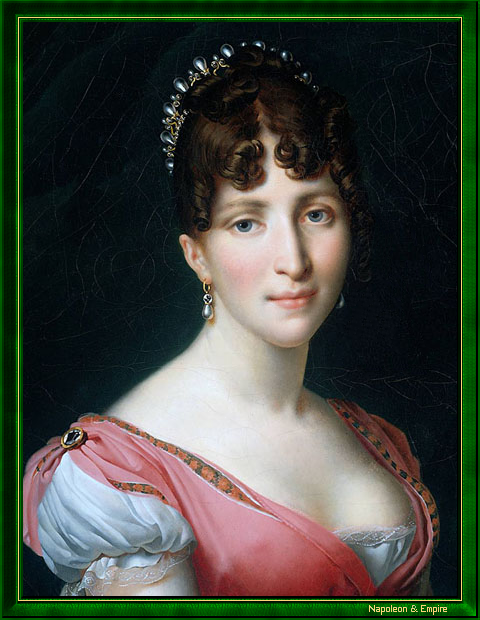
Queen Hortense, a music-lover and musician, composed numerous romances, including the 1807 melodie du Beau Dunois, better known as Partant pour la Syrie, which became a rallying song for Bonapartists under the Restoration.
Other portraits
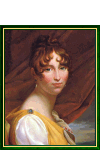
Enlarge
"Hortense de Beauharnais" by François Pascal Simon Gerard (Rome 1770 - Paris 1837).
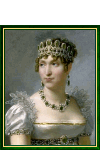
Enlarge
"Hortense de Beauharnais" by Jean-Baptiste Regnault (Paris 1754 - Paris 1829).
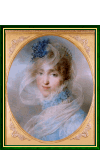
Enlarge
"Hortense de Beauharnais". Miniature by Jean-Baptiste Isabey (Nancy 1767 - Paris 1855).